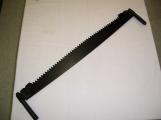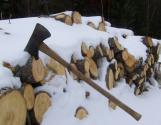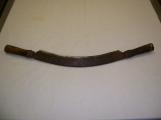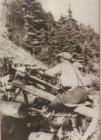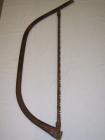1
Methods of harvesting wood have changed over the years. The improvement of tools has made logging operations more efficient. When the loggers first came to harvest the wood in Bay d'Espoir, the only tools used for harvesting wood were the cross cut saw and a double bitted axe.3
The cross cut saw is a hand saw which required two men to handle it, weighing approximately 30 pounds with a blade of five inches in width and five to six feet long.5
The double bitted axe is an axe with a double edge blade. The logger would use the axe to cut a notch in the tree to help guide the direction in which it fell. Two loggers would then use the cross cut to saw on the opposite side of the notch to fell the tree. The axe was also used to remove the limbs (limbing), as the loggers were not allowed to use the saw to do this. This method of felling the trees was slow and cumbersome; producing approximately one cord a day between the two men.7
Some of the logs required the bark to be removed. This was done with a rinding knife (also called a drawing or jack knife). This instrument had a curved blade with a wooden handle on each end.9
The man doing the rinding sometimes sat on a "hob" to accomplish this job. The "hob" was similar to a wood horse, having four legs and a seat at one end for the logger and a place to put the log on the other end.11
In the early 1920's the cross cut saw was replaced by the buck saw. The buck saw consisted of a small thin blade about an inch wide and three and a half to four feet long attached to a bow. The buck saw could be used by one logger proving to be a satisfactory cutting instrument and, together with the axe, were used exclusively for wood cutting until the power saw was introduced in 1952.13
The loggers had the use of handcats to haul four to six logs (depending on the size) out of the woods. The handcat was a sled with a long wooden handle and rope attached to it. The men would tow the sled with the rope and guide it with the handle.A local lady remembers her father coming home for the weekend from the logging camp with rope burns on his shoulders from hauling the logs and having her mother treat his burns with ointment.
